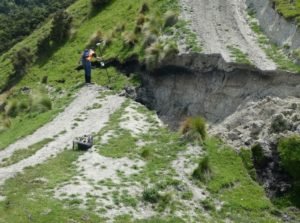 |
| Photo Tim Little @ VUW |
Whilst there were many faults that ruptured during the recent M7.8 Kaikoura Earthquake, the Kekerengu Fault is perhaps the most awe inspiring in terms of its effect on the landscape and infrastructure. As it ripped through the countryside, it displaced the land to either side by an astonishing 8 to 10 metres sideways and about 2 metres vertically over many kilometres of its length.
 |
|
| Kekerengu Fault offset, J.Thomson @ GNS Science |
In places this horizontal offset is even more – up to a whopping 12 m. This is impressive on a global scale. In the first two images here you can see what this looks like where farm tracks have been sliced through at a right angle.
Here is a drone’s eye view from above:
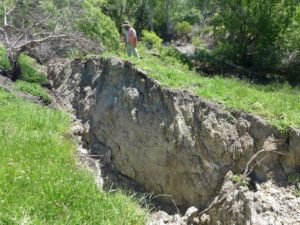 |
| Kekerengu Fault, J.Thomson @ GNS Science |
As the trace of the fault passes through different locations, it expresses itself in a number of ways.
Across the river from Bluff Station, it has opened up an enormous crevasse, not unlike the sort of thing that mountaineers often see on a glacier. This will be due to either a slight bend in the fault trace, and/or slumping of the downhill side of the fault where there is a slope.
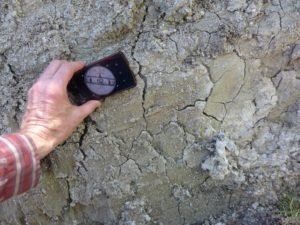 |
| Kekerengu Fault, J.Thomson @ GNS Science |
 |
| Kekerengu Fault, J.Thomson @ GNS Science |
 |
| Kekerengu Fault, J.Thomson @ GNS Science |
…whereas in other places, the slip is distributed over a broad area of surface deformation. In this case it is likely that the groundshaking helped the hillside follow the call of gravity to spread the deformation over a large area.
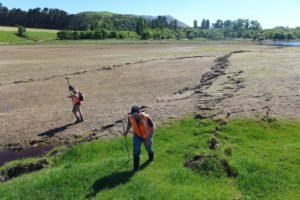 |
| Kekerengu Fault, J.Thomson @ GNS Science |
Near to the coast, the Kekerengu Fault tracks across this field towards the main state highway and the railway. Here the fault trace is a mound of huge clods of earth and ripped turf. We call this a “mole track”, and it results from some compression rather than extension along this part of the fault trace.
 |
| Kekerengu Fault, J.Thomson @ GNS Science |
Not far away, State Highway 1 has been pushed sideways in several pieces…
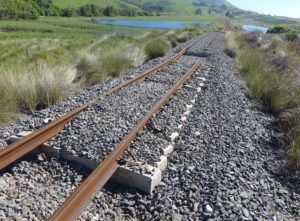 |
| Kekerengu Fault, J.Thomson @ GNS Science |
and the nearby railway has been pulled so hard that it snapped.
 |
| Kekerengu Fault, J.Thomson @ GNS Science |
The fault runs right under this small bridge which is totally destroyed.
 |
| Kekerengu Fault, J.Thomson @ GNS Science |
Lots of food for thought and plenty of work ahead for earthquake scientist Russ van Dissen and his colleagues.



Stupendous energy involved in that deformation. One can only imagine what the moment must have sounded like there on the ground.
[Valerie]
I'm just astounded that GNS have stated this whole event has had absolutely no effect on the pressure around the Alpine Fault, so much land movement ? !!
Interesting there's been no Alpine fault pressure readings given ?.
Interesting!
Astonishing energy is found in that deformation. Can you imagine, what the moment must have sounded like there on the ground.
This comment has been removed by a blog administrator.
terimakasih mas buat infonya dan salam kenal
mantap sob infonya dan salam sukses selalu
bagus bos artikelnya dan menarik
makasih gan buat infonya dan semoga bermanfaat
makasih gan buat infonya dan semoga bermanfaat
bagus bos artikelnya dan menarik
semoga sukses terus gan buat usahanya
Kabar Baik Untuk Para pencinta Game
Karena di Bulan januari ini Sudah keluar Game RPG Online Terpopuler Se-Asia
Penasarankan Game nya Seperti apa???
Kalian bisa dilihat game nya dari link di bawah yaaa